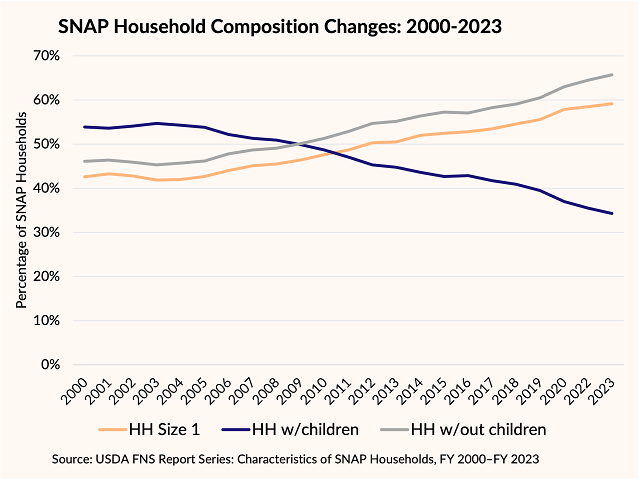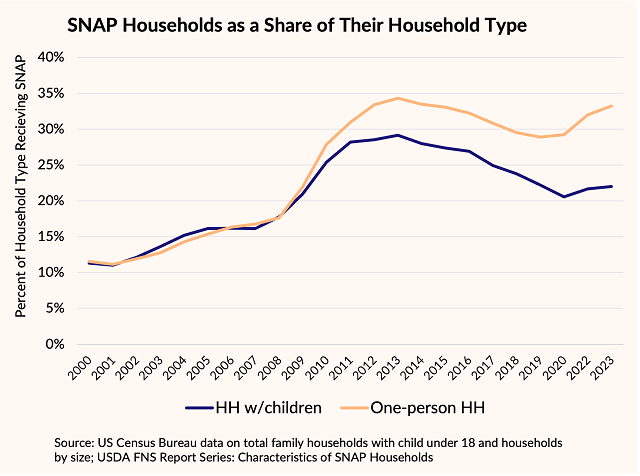Highlights
- SNAP has grown substantially in both participation and costs in recent years. Post This
- In FY 2023, almost two-thirds of SNAP households were childless, and 60% were single-person households. Post This
- SNAP has moved away from primarily serving families with children toward serving households without children, particularly those consisting of just one person. Post This
An underappreciated trend in the Supplemental Nutrition Assistance Program (SNAP)—formerly the Food Stamp Program—over the past two decades is the shift in participation toward childless households, particularly single-person households without children. In FY 2023 (the most recent year of data), almost two-thirds of SNAP households were childless, and 60% were single-person households. This represents a sharp contrast with two decades ago, when the majority of SNAP households included children. This trend has important implications for the future of SNAP that federal policymakers should consider.
As recently discussed in these pages, marriage trends present a complicated picture of how families are forming in the United States. On one hand, marriage has stabilized as the primary setting for having and raising children following a steep decline that began in the 1970s. But as Brad Wilcox and his coauthors caution, the picture is not uniformly positive. Overall, marriage rates continue to decline, suggesting that while marriage as the preferred institution for raising children may be holding steady, marriage as a broader social institution is still in retreat.
One might reasonably expect that the stabilization of children being raised in married households would slow the growth of safety net programs such as SNAP, given that households with children—particularly those headed by single parents—are disproportionately poor and in need of assistance. Instead, the opposite trend has occurred.
SNAP is the nation’s primary food assistance program for low-income households, providing nearly $100 billion annually in benefits—making it the largest safety net program after Medicaid. Participants receive monthly benefits through a debit-like card to help them purchase groceries. As shown in the figure below, instead of stabilizing, SNAP has grown substantially in both participation and costs in recent years. Even after adjusting for population growth, my estimates show that the share of the population receiving benefits has nearly doubled over the past two decades, increasing from about 6% in 2000 to roughly 12% by 2019 when the unemployment rate was at historic lows.

This overall growth masks profound shifts in the composition of SNAP households. As the figure below shows, the program has moved away from primarily serving families with children toward serving households without children, particularly those consisting of just one person. In FY 2000, a majority (53.9%) of SNAP households included children, and 42.6% of all SNAP households involved one person. By contrast, in FY 2023, only 34.3% of SNAP households included children—with a record 65.7% having no children—and 59.2% were single-person households.

What explains this shift? Changes in the composition of American households likely plays a role—most notably, the rise in childless households. According to my calculations using U.S. Census Bureau data, the share of total US households without children grew from 67.0% in 2000 to 74.6% in 2023. Meanwhile, according to the Census Bureau, the share of single-person households rose modestly during this time, from 25.8% in 2000 to 27.6% in 2023.
While a shift toward childless and single-person households within SNAP would be expected given these broader population trends, SNAP participation among childless and single-person households has now dramatically outpaced participation among households with children. In other words, SNAP’s growth has been strongest among childless and single-person households at the same time that Americans have increasingly shifted toward these living arrangements.
Until around 2009, households with children and single-person households participated in SNAP at roughly the same rate—about 21% and 22%, respectively (see figure below).1 After 2009, however, the trends diverged. By FY 2023, participation among single-person households had risen to 33%, while participation among households with children remained essentially unchanged (22%). While differences between SNAP administrative data and Census household data account for some of this divergence, the broader pattern is clear: SNAP participation is increasingly concentrated among childless and especially single-person households.

Childless households now represent a larger share of all US households, and their growing reliance on SNAP raises important questions about health, employment, and long-term self-sufficiency. For these reasons, policymakers concerned over SNAP’s reach and growth should focus on childless households, particularly those with only one person. A critical first step is ensuring that all single-person SNAP households are legitimately eligible. Under current rules, individuals living in the same residence may qualify as separate SNAP households if they do not purchase and prepare meals together. Yet state agencies have limited resources—and little incentive—to verify such claims. The default assumption should be that all household members are part of the same SNAP unit unless an applicant can provide documentation that they maintain separate food budgets.
Beyond integrity measures, employment must remain a central focus within SNAP. Childless adults typically receive SNAP for one of two reasons: either they are capable of working but unemployed (or unstably employed), or they face health limitations or age-related barriers that prevent work. For those able to work, the recent changes to SNAP’s work requirements in the OBBBA represent progress. By limiting states’ ability to waive work requirements during periods of low unemployment, the reforms ensure that work-capable participants engage in employment or related activities as a condition of receiving benefits.
Much more remains to be done for childless SNAP participants who are disabled or cannot currently work due to other health-related limitations. Many of these individuals could benefit from employment with the proper accommodations or through treatment. As my colleague Thomas O’Rourke and I noted in a 2023 report, SNAP participants disproportionately report poor health—a factor that helps explain their reliance on the program. Yet SNAP may worsen these challenges by subsidizing unhealthy diets and supporting idleness. Strengthening the program to promote better nutrition would not only improve participants’ health but also support their eventual return to work. Progress is beginning on this front as well, with the USDA already approving requests from 12 states to restrict what participants can purchase with SNAP starting in 2026.
The outlook for families with children in the United States is improving, with marriage rates and SNAP participation showing signs of stabilization. By contrast, the growing share of childless households—particularly single-person households—served through SNAP underscores the need to reassess program policies in light of who the program now serves.
Angela Rachidi is the Rowe Scholar in poverty studies at the American Enterprise Institute where she studies policies that affect low-income children and families.
1. Note: Reflects (1) the number of SNAP households with children using SNAP administrative data as a percentage of all US family households with children under 18 using Census data and (2) the number of SNAP households size one using SNAP administrative data as a share of all US households size one using Census data. One way to explain away this trend could be that single-person SNAP households have increasingly been counted as part of multiple-person Census households. More analysis is needed to understand these dynamics better.














